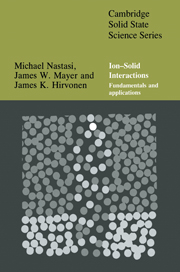Book contents
- Frontmatter
- Contents
- List of symbols
- Preface
- Chapter 1 General features and fundamental concepts
- Chapter 2 Interatomic potentials
- Chapter 3 Dynamics of binary elastic collisions
- Chapter 4 Cross-section
- Chapter 5 Ion stopping
- Chapter 6 Ion range and range distribution
- Chapter 7 Radiation damage and spikes
- Chapter 8 Ion–solid simulations and diffusion
- Chapter 9 Sputtering
- Chapter 10 Order–disorder and ion implantation metallurgy
- Chapter 11 Ion beam mixing
- Chapter 12 Phase transformations
- Chapter 13 Ion beam assisted deposition
- Chapter 14 Applications of ion beam processing techniques
- Chapter 15 Ion beam system features
- Appendix A Crystallography
- Appendix B Table of the elements
- Appendix C Density of states
- Appendix D Derivation of the Thomas–Fermi differential equation
- Appendix E Center-of-mass and laboratory scattering angles
- Appendix F Miedema's semi-empirical model for the enthalpy of formation in the liquid and solid states
- Appendix G Implantation metallurgy – study of equilibrium alloys
- Appendix H Physical constants, conversions and useful combinations
- Index
Chapter 15 - Ion beam system features
Published online by Cambridge University Press: 27 January 2010
- Frontmatter
- Contents
- List of symbols
- Preface
- Chapter 1 General features and fundamental concepts
- Chapter 2 Interatomic potentials
- Chapter 3 Dynamics of binary elastic collisions
- Chapter 4 Cross-section
- Chapter 5 Ion stopping
- Chapter 6 Ion range and range distribution
- Chapter 7 Radiation damage and spikes
- Chapter 8 Ion–solid simulations and diffusion
- Chapter 9 Sputtering
- Chapter 10 Order–disorder and ion implantation metallurgy
- Chapter 11 Ion beam mixing
- Chapter 12 Phase transformations
- Chapter 13 Ion beam assisted deposition
- Chapter 14 Applications of ion beam processing techniques
- Chapter 15 Ion beam system features
- Appendix A Crystallography
- Appendix B Table of the elements
- Appendix C Density of states
- Appendix D Derivation of the Thomas–Fermi differential equation
- Appendix E Center-of-mass and laboratory scattering angles
- Appendix F Miedema's semi-empirical model for the enthalpy of formation in the liquid and solid states
- Appendix G Implantation metallurgy – study of equilibrium alloys
- Appendix H Physical constants, conversions and useful combinations
- Index
Summary
Introduction
The ion beam systems currently employed for surface modification studies involving either direct ion beam implantation or ion beam assisted deposition have evolved from distinctly different predecessors, including isotope separators and exploratory space propulsion devices, respectively. The features of directed beam ion implanters will be discussed first, followed by features of plasma source ion implantation (PSII), and finally the lower-energy broad-beam ion sources commonly used for IBAD studies.
The earliest ion implanters evolved from the isotope separators of the 1940s and later. Ion implanters are frequently classed according to their ion current capabilities, ranging from low currents (i.e., microampères) to high currents (one to several milliampères). The specific design criteria have been mainly driven by the particular fluence (dose) and depth profile requirements for semiconductor device fabrication. The history of ion implanter evolution and development is in itself an interesting study of technology transfer. It is covered comprehensively in a series of Conference Proceedings (see the Suggested reading section) that parallel the developments in Si device technology that has demonstrated such explosive growth since the early 1970s (Rose, 1985). Although this area of accelerator application is not the focus of this book, many ion implanters in research and development usage today, for general materials science studies, are either converted semiconductor ion implanters or are based on their design. Therefore, the basic design and system features of these systems will be briefly treated.
- Type
- Chapter
- Information
- Ion-Solid InteractionsFundamentals and Applications, pp. 455 - 482Publisher: Cambridge University PressPrint publication year: 1996
- 2
- Cited by



